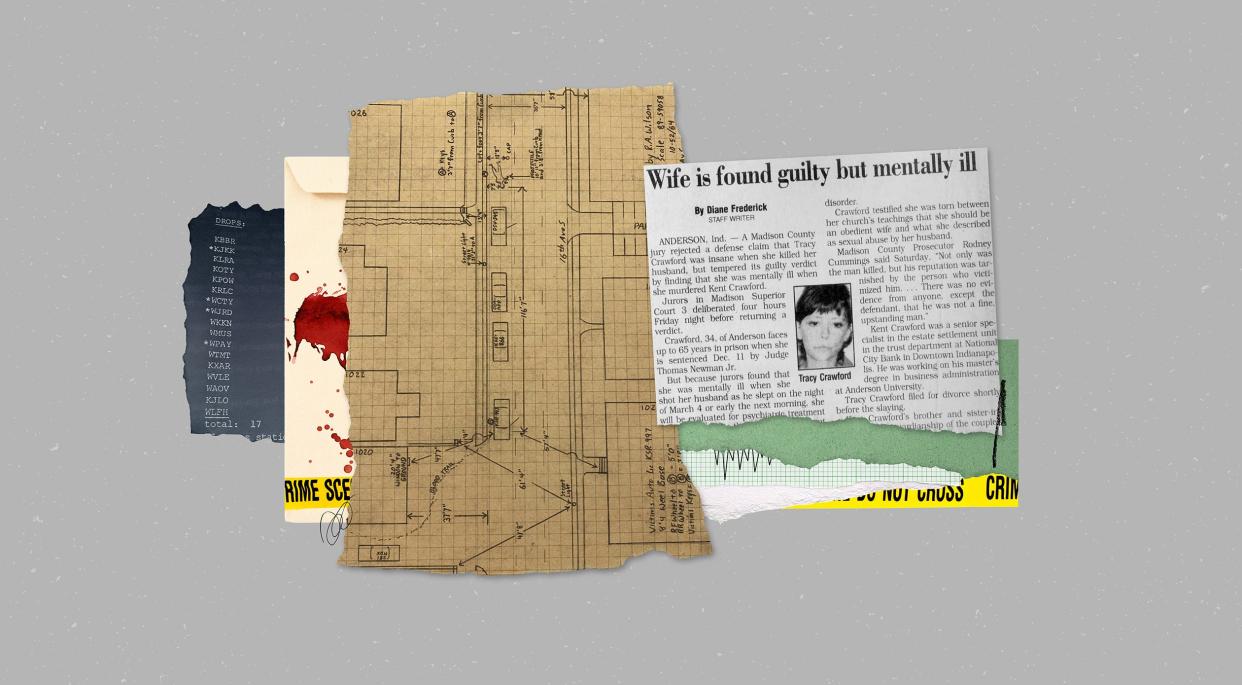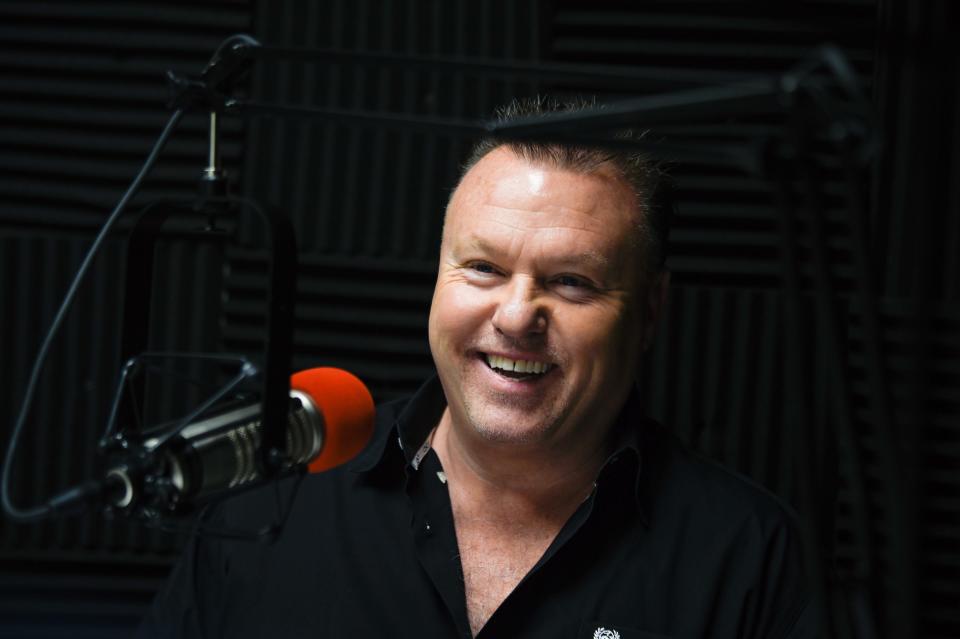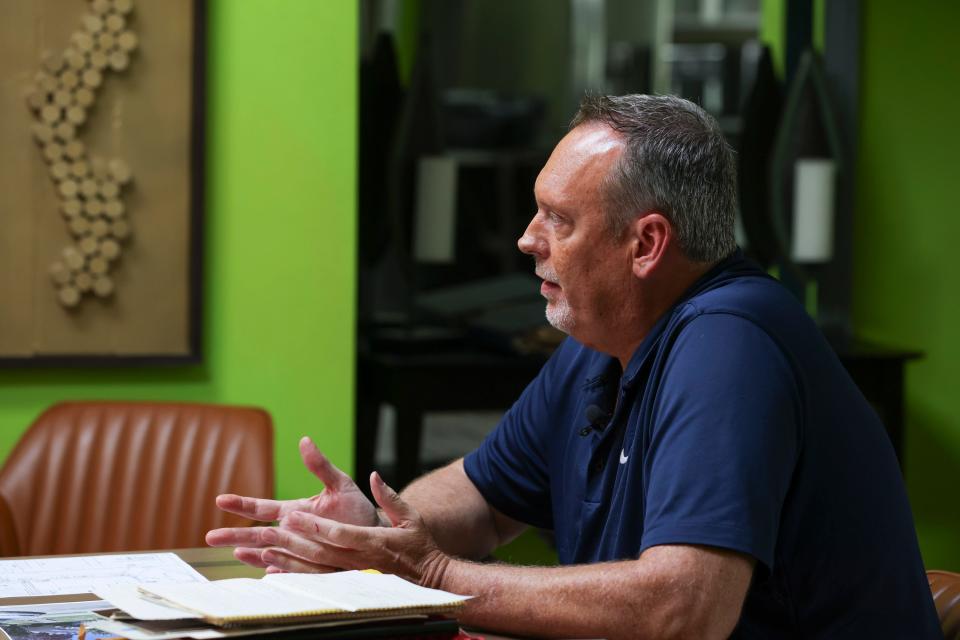Murder on Music Row: Phone calls reveal anger, tension on Hughes' last day alive

This is the sixth in an eight-part series exploring the 1989 murder of Kevin Hughes, a country music chart director who knew too much.
Sammy Sadler met a woman.
He was at the Country Radio Seminar during the first week of March in 1989. That was the year an up-and-comer named Garth Brooks set the standard for working the CRS crowd and making everyone love him with a handshake, an autograph or an unforgettable acoustic performance.
Sadler said his goal at the Opryland Hotel, CRS’ home, was to smile a lot, be nice, and meet a lot of people.
One of those people, as it turned out, was named Kathy.

His interest in Kathy was not professional in nature. Sadler’s marriage, which was in the midst of failure, did not stop him from discreet pursuits.
Sadler said his memory, 34 years later, is murky, but …
“I may have done that,” he said with a sly smile. “This is probably somebody I met and hooked up with. Musicians are known to stray a little bit. I was probably guilty of doing it like a lot of ‘em. We probably have done things we’re not proud of and shouldn’t have done.”
Kathy told police she gave Sadler her phone number.
When detectives Bill Pridemore and Pat Postiglione questioned Sadler after the murder of Kevin Hughes, they discovered he had been serially unfaithful to his wife Jeania.
More precisely, he had first lied to the police about his romantic entanglements until Pridemore called his father, Jerry, in Texas and urged the elder Sadler to convince his son to tell the truth.
Pushed by his father, Sadler revealed he was seeing three women (who were not his wife) before March 1989.
Kathy was a fourth. She was new.
According to Kathy’s interview with detectives, Sadler called her Monday, Tuesday, Wednesday and Thursday of that week, his final call on the morning of the murder.
Sammy told her to meet at Evergreen Records office

The phone records from March 9, 1989 paint an interesting picture.
Sadler called his father in Texas at 7:48 a.m.
Sadler was at his apartment in Donelson, but he charged the call to Evergreen Records. (That was a detail that would become important later). In the 1980s, long distance calls were supremely expensive with fees for the first three minutes compounded by more fees for each additional minute.
At 9:01 a.m., he called his father again, and again he charged the call to Evergreen Records. Sadler said he doesn’t remember what they discussed in those calls.
His third call of that day may have been to Kathy. He said he doesn’t remember making the call. There were no records kept of local calls.
But Kathy told police he called her. In a supplemental report from April 3, 1989, at 2 p.m., she said he told her he wanted to meet her later that night at Evergreen Records, the office where he worked on 16th Avenue South. She agreed. He said he would call her back at around 4:30 p.m. to give her the time she should come.
Kevin drops four radio stations, changing chart

The next call is one that caught Pridemore’s attention.
In an interview Sadler gave while he was still recovering from the gunshot wound, he said he called Hughes on the morning of the murder.
In that call, Hughes revealed he would be changing the way he compiled the independent music chart. Hughes said he would be disregarding the reports of four radio stations he believed were inaccurate.
They were KJKK in Dallas, WCTY in Norwich, Connecticut, WJRD in Tuscaloosa, Alabama, and WPAY in Portsmouth, Ohio.
All of those were called “pocket stations” of promoter Chuck Dixon, meaning Hughes believed Dixon had them in his pocket. Each of them had changed formats where they weren’t playing as much country music.
Pridemore’s report said in his familiar all caps: “SAMMIE STATED ON THURSDAY MORNING, THE DAY KEVIN WAS KILLED, KEVIN HAD TOLD HIM THAT HE WAS DROPPING THE STATIONS.”
In a recent interview, Sadler said: “I don’t remember him telling me anything about dropping stations.”
But in his book “Hit With A Bullet” on page 67, Sadler has the following passage about the day Hughes died:
“Kevin told me earlier in the day that he had dropped some more stations from the Independent chart,” Sadler wrote. “I think he had dropped four stations.”
Pridemore’s report from March 17, 1989, said Sadler then called Chuck Dixon.
But he couldn’t reach Dixon.
So Sadler drove to Dixon’s office to give him the news in-person about Hughes’ decision to drop the stations and change the charts.
Pridemore’s report said: “CHUCK WAS NOT IN. SAMMIE LEFT A NOTE INFORMING HIM OF THE DROP.”
In the recent interview, Sadler said he didn’t drive to Dixon’s office.
When asked if Pridemore (on March 17, 1989 — eight days after the murder) made up a false report, Sadler said: “I don’t believe a lot of stuff that they (police) say.”
(There was a witness who confirmed Pridemore’s account. Thirteen years after the murder, Sharon Corbitt had a change of heart. There will be more about that later in this narrative.)
According to Pridemore’s report, on the afternoon of March 9, Dixon called Sadler and asked, “Why is Kevin doing this?” Sadler told Dixon he didn’t know.
Hughes’ insistence on cleaning up the chart meant that Sadler’s song “Tell It Like It Is” would drop off.
In Dixon’s interview with police on March 20, 1989, he said he talked to Sadler on the phone on the day Hughes died and they discussed the dropping of the stations.
Sharon Pennington, who was Hughes’ close friend, and Cecilia Walker, who worked with Hughes in the Cash Box office, both told police Dixon called them several times that afternoon asking why Hughes was taking this step to clean up the charts.
Finally, Dixon called Hughes in the late afternoon. Dixon told police he and Hughes discussed the dropping of the stations.
One note: After the revelation that Hughes was dropping radio stations and tightening the accuracy of the Cash Box Independent chart, Sammy Sadler did not call back Kathy.
She told police he didn’t call her at 4:30 p.m. and didn’t make plans to see her that night.
Another man shot in the head

Kent Crawford had known Hughes since 1983 when they were students at Belmont College.
On March 15, 1989, Pridemore interviewed him.
Crawford had called Hughes at about 5 p.m. on March 9, about 5 ½ hours before he was killed. Hughes was sitting at his desk at the Cash Box office.
Crawford said Hughes told him he had plans for the night of March 9. He was going to the movies (“Bill and Ted’s Excellent Adventure”) with a friend (Sharon Pennington), then “going riding around with a friend.”
A note about Crawford. He would eventually move to Indiana and get married. Then he was killed by his wife. Two Belmont friends, Hughes and Crawford, both shot in the head.
Pennington indeed went to the movies with Hughes. She told police they talked in the theater. Chuck Dixon had called Pennington during the day and asked her to talk to Hughes about dropping the four radio stations.
Pennington would later tell Pridemore Hughes was “very upset” after hearing about Dixon talking to her.
The archives of The Tennessean show Bill and Ted was playing at the Fountain Square AMC theater at 5:30 p.m. The wacky movie has a running time of 1 hour and 30 minutes, meaning it was scheduled to end, given the showing of trailers of upcoming movies, a few minutes after 7 p.m.
If he watched the full movie, Hughes wouldn’t be back to the Cash Box office until about 7:30 p.m. at the earliest.
Crawford’s call was important for two reasons.
First, Hughes was a notoriously hard worker who often stayed late, especially the night before Cash Box publication. But on this night, he was taking off for several hours in the middle of his busiest shift.
In his book, Sadler wrote: “When I got home, my wife and I got into an argument. It was one of those disagreements that cools down for a little while and then blows up again. After nightfall, I realized it might be best for both of us if I went out and got some air …
“I knew Kevin would still be in the office, so I called him. I knew he might have plans already but sometime after 8, maybe 8:30, I called him anyway.”
(Sammy’s book includes the argument story. But in his comments to police in 1989, this argument was never mentioned.)
On March 9, 1989, sunset was at 5:50 p.m.
At 7:30 p.m., Hughes was indeed back in his office because he called his brother Kyle, who thought his brother sounded nervous and scared. Hughes didn’t explain why he felt that way. He told his brother he would come home the following weekend and fill him in on the details.

“My mom and dad were gone that night,” Kyle Hughes said. “I don’t know if they were at church. I was at home studying for a physics test. I was at U of Evansville. I was at home. Phone rang. I went to my mom and dad’s room to get it. We talked for about 10, 15 maybe 20 minutes. He was supposed to come home that weekend.
“He would always ask about me, my basketball. How’s school going? What’s going on? Then he would talk about himself a little bit, about what was going on with him. He just said that I’ve got something to talk about. I don’t want to talk on the phone. I want to talk about it when I get home. I want you to be part of the conversation. He didn’t tell me anything over the phone. Then at the end of the conversation, he told me he loved me, which he never did before.”
Kyle Hughes said he knew something was wrong.
Kevin told witness: Sammy is upset

At 7:44 p.m., Sadler was still home and made his third call of the day to his father in Texas. He said he doesn’t remember what they talked about.
Over the next 45 minutes, there were three calls between Dixon and Hughes (while Hughes was at his desk at Cash Box) on the night of the murder.
Dixon said they had talked between 8 p.m. and 8:30 p.m. about the next day’s chart, but the dropping of the four stations didn’t come up. According to police reports, Dixon made at least 10 calls to Sadler, Pennington, Walker and Hughes about the dropping of the radio stations.
At 8:30 p.m., Leslie Levin, a friend of Hughes’ who was working at the Belmont library, called Hughes asking for a ride home.
Hughes said he couldn’t.
Det. Pat Postiglione interviewed Levin on March 14, 1989, five days after the murder.
Levin told Postiglione: “Sammy was coming to his (Hughes’) office and was upset. They had to get it worked out.”
Levin said Hughes was also upset when he talked to him two hours before the murder.
Sadler said in a recent interview he was not upset at all. His visit was completely random, unscripted.
Random stop to make another phone call

At 8:41 p.m. Sadler was with Hughes in the Cash Box office. We know this because he made another call to his father in Texas. It was his fourth call to his father of the day and second in the last hour.
Sadler said he didn’t think it was unusual that he kept calling his father.
At 9 p.m. Sadler and Hughes went in Hughes’ car to eat at Captain D’s on West End.
On the way back from the restaurant, Sadler told police he suggested an unplanned stop at Evergreen Records at 1021 16th Ave. S. He said he wanted to make a long distance call for which he wouldn’t have to pay because it was on his office phone.
Sadler, who was accustomed to making calls from his home and charging them to Evergreen, could have made that call from anywhere for free (if he charged the call to Evergreen). But he wanted to stop at Evergreen.
Sadler said he called his parents in Texas (which would be his fifth call of the day to that number). Every other long distance call mentioned in this account is reflected in police records.
This 10 p.m. call from Evergreen to Texas is not.
Jerry Sadler insisted to police his son had called at 10 p.m. from the Evergreen office. Later, Evergreen owner Johnny Morris told police he had a phone bill with a 10 p.m. call reflected. But Morris never produced that bill for the police.
“WE COULD NOT LOCATE A PHONE CALL FROM EVERGREEN RECORDS OR SAMMIE’S HOME DURING THE PERIOD SAMMIE SAID HE CALLED BONHAM, TX,” Pridemore wrote in his typical all caps report on April 5, 1989.
In the next 25 minutes, a ski-masked killer would ambush Sadler and Hughes outside Evergreen Records.
Pridemore said he believed the killer was hiding in the shadows between the buildings before he raced to the car and shot Sadler, then chased and killed Hughes. There were no other walls or foliage behind which a killer could hide.
If the killer was between the buildings, he would have had to cover, according to a police diagram, 40 feet without being seen by Sadler and wedge himself inside the car door before Sadler could close it. Remember, Sadler said the killer’s stance had blocked him from closing the passenger’s side door.
The car window was not rolled down. The window was not shattered by a bullet. The killer’s back was against the inside of the window with the car door open.
Sadler said he had not paused before he tried to close the door. He said he sat down and tried to close the door in one continuous motion, but he couldn’t because the shooter got wedged in there.
How did the killer travel 40 feet, unseen, in the blink of an eye, unless …
The killer wasn’t between the buildings.
If the killer was ducking behind the rear of the car, he could easily step forward and wedge himself inside the door.
Sadler has been interviewed many, many times over the years. He always says he walked “in front” of the car to get into the passenger’s seat.
If the killer was ducking behind the rear passenger side of the car, he would have been less than five feet away as Sadler opened his door.
Pridemore’s conclusion?
“I thought Sammy may have something to do with it,” the lead detective said. “He was shot, but he wasn’t killed. For a long time, I thought he set it all up.”
Sadler passed a lie detector test, and he was hypnotized to see if he would tell a different story.
Pridemore said he didn’t believe Sadler was ever under hypnosis.
“I don’t think he was fully committed to the hypnosis,” Pridemore said. “I think he was playing along.”
Here’s the bottom line: Sadler was suspected of being involved in the murder, but never arrested and never charged.
“I’m not a suspect,” Sadler told The Tennessean. “I don’t have anything to do with any of this. I’m an innocent bystander. Getting shot, my friend gets killed, it’s not right.
“The police made accusations toward me that are not true.”
Evergreen surrounded by police

Kathy was visiting a friend who lived on Music Row on the night of March 9, 1989, the same night she was hoping to meet Sadler at Evergreen Records.
She didn’t know why Sadler had skipped his call to her to set up a meeting. She didn’t know about the shooting.
She told police curiosity got the best of her, and sometime after 10:30 p.m., she drove down 16th Ave. S. to check out the Evergreen office.
The place was surrounded by police.
Kathy drove past on her way home.
For the next three weeks, she attempted to reach Sadler.
He never returned her call.
This article originally appeared on Nashville Tennessean: Nashville crime: Calls show what Kevin Hughes' final day was like

